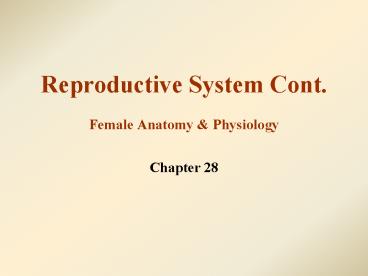Reproductive System Cont. Female Anatomy - PowerPoint PPT Presentation
1 / 9
Title:
Reproductive System Cont. Female Anatomy
Description:
Female Anatomy & Physiology Chapter ... = transport eggs from the ovary to the uterus; ... occur in the uterus Last 28 days on average Influenced by 1. hormones ... – PowerPoint PPT presentation
Number of Views:244
Avg rating:3.0/5.0
Title: Reproductive System Cont. Female Anatomy
1
Reproductive System Cont.Female Anatomy
Physiology
- Chapter 28
2
FEMALE ANATOMY
- Ovaries produce eggs
- Ovarian follicles contain eggs in various
stages of development and the cells that surround
them surrounding cells nourish the eggs
produce estrogen - Corpus luteum remnants of a mature follicle
after ovulation (after egg is released) produces
estrogen, progesterone, and relaxin
3
- Uterine tubes (oviducts/fallopian tubes)
transport eggs from the ovary to the uterus
fertilization occurs in the oviducts - Uterus organ in which the fetus develops
- Endometrium uterine lining
- Cervix lower end of uterus
- Vagina passageway between the uterus and the
outside - Vulva external genitals of the female
4
Female Reproductive Cycles1. Ovarian Cycle
2. Menstrual (Uterine) Cycle
5
Female Reproductive Cycles
- Female reproductive cycles prepare the female
body for pregnancy - 1. Ovarian cycle cyclic events that occur in
the ovaries - 2. Menstrual (uterine) cycle cyclic events that
occur in the uterus - Last 28 days on average
- Influenced by
- 1. hormones secreted by pituitary gland FSH and
LH - 2. hormones secreted by ovary estrogen and
progesterone
6
OVARIAN CYCLE
- 1. Follicular phase prior to ovulation
- One ovarian follicle becomes the dominant
follicle and begins to mature when the pituitary
gland releases FSH - Maturing follicle releases estrogen and causes
the pituitary gland to release LH (this is an
example of positive feedback an increase in one
hormone results in increase of another hormone) - 2. Ovulation (day 14)
- levels of LH reach its peak and initiate
ovulation - Ovulation egg is released from the dominant
follicle - 3. Luteal phase after ovulation
- Ruptured follicle becomes corpus luteum and
secretes estrogen and progesterone - High levels of estrogen and progesterone inhibit
FSH and LH (this is an example of negative
feedback increase in one hormone results in
decrease of another hormone)
7
MENSTRUAL CYCLE
- If the egg does not become fertilized, levels of
estrogen and progesterone fall and cause
endometrium to be shed menstrual flow or
menstruation (days 1-5) - Starting with day 6, increasing levels of
estrogen cause endometrium to thicken and prepare
uterus for possible implantation of fertilized egg
8
FERTILIZATION
- Fertilization union of sperm and egg the
resulting cell is called zygote - Takes place in the uterine tube
9
IMPLENTATION
- Implentation the zygote passes into the uterus
where it attaches into the uterine lining (by the
sixth day after fertilization)































